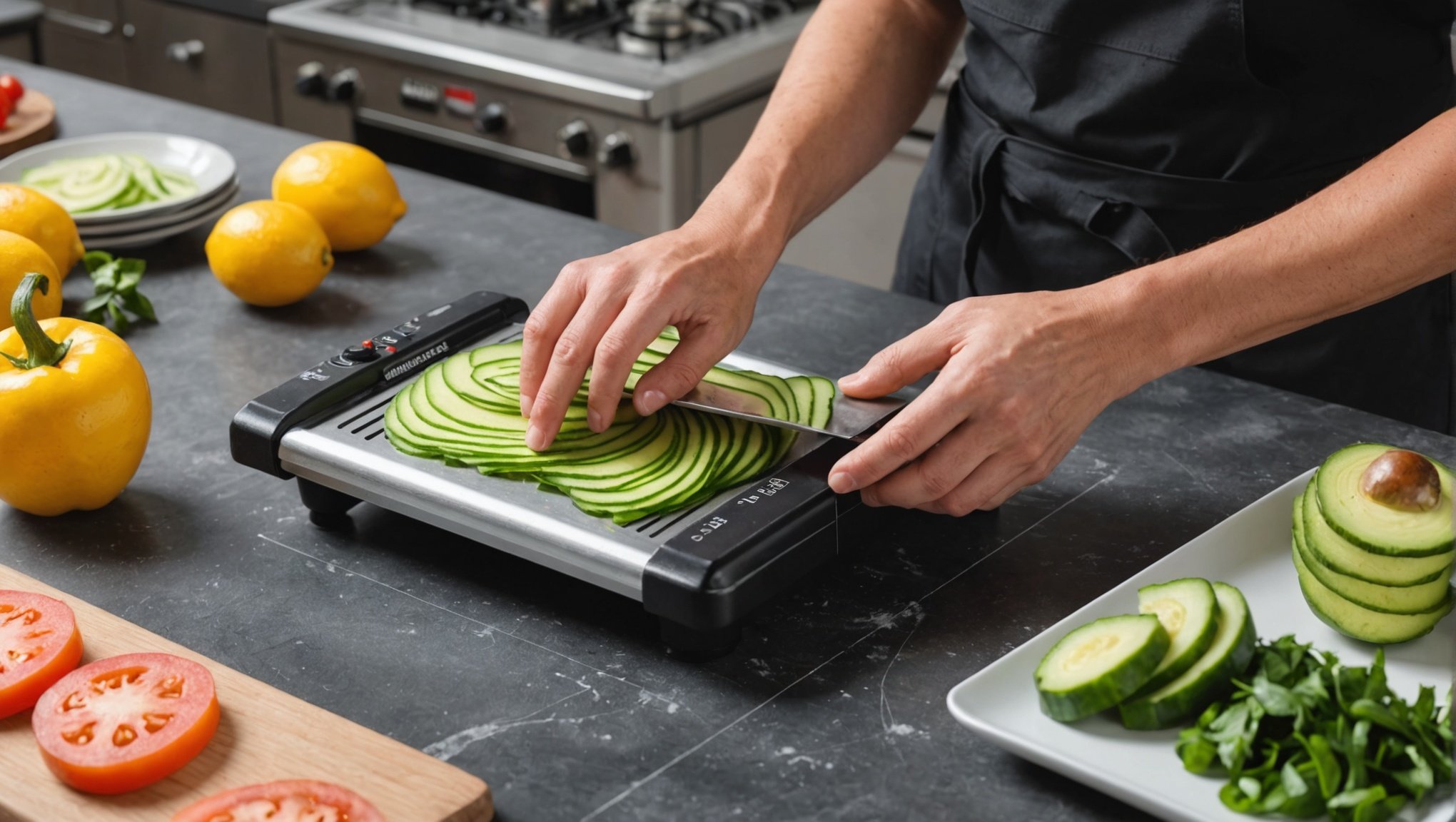Mandoline slicing can elevate your culinary skills, adding precision and flair to your dishes. However, the risk of injury is a common concern for many home cooks. Mastering safe mandoline techniques not only protects you but also boosts your confidence in the kitchen. By incorporating simple practices and proper tools, you can enjoy injury-free food prep while achieving professional-looking results. Let’s explore essential methods that ensure a safer slicing experience, transforming your cooking routine.
Understanding Mandoline Slicers
Mandoline slicers are essential kitchen tools designed for precision cutting, making them a favourite among culinary enthusiasts. These devices allow for quick and uniform slicing of fruits and vegetables, enhancing both the efficiency and aesthetics of food preparation.
This might interest you : Choosing the Perfect Fish Poacher for Healthy Cooking: A Guide for Health-Conscious Chefs
Several types of mandolines are available, each catering to different needs. Basic models offer straight blades for simple slicing tasks, while more advanced versions include interchangeable blades for julienne, crinkle, or waffle cuts. Adjustable thickness settings are also common, providing versatility in slice thickness.
The operation of mandoline slicers is straightforward yet effective. Users glide the food item across the blade, achieving consistent slices with minimal effort. This method is notably faster and more precise than traditional knife slicing, reducing preparation time significantly. Additionally, mandoline slicers often come with a hand guard to ensure safety during use.
Also to read : Unlocking the Perfect Pizza: Essential Features of a Pizza Stone for Crispy Crusts in Your Home Oven
The advantages of using mandoline slicers over traditional methods are numerous. They offer uniformity in slice size, which is crucial for even cooking and presentation. Moreover, their efficiency saves time in the kitchen, making them an invaluable tool for both professional chefs and home cooks alike.
Importance of Safety in Food Preparation
Ensuring kitchen safety is paramount, especially when using tools like mandoline slicers. Statistics reveal that a significant number of kitchen injuries stem from improper slicing techniques. Prioritising food prep safety can prevent these incidents, making the culinary experience more enjoyable and less risky.
Common Injuries and Prevention
Mandoline slicers, while efficient, pose a risk if not used correctly. Common injuries include deep cuts and lacerations, often due to the sharpness of the blades and improper handling. Injury prevention begins with understanding the tool and using protective gear. Many slicers come with hand guards, which should always be used to shield fingers from the blade.
Prioritising Safety
To further enhance safety, ensure the mandoline is placed on a stable surface to avoid slips. Additionally, familiarising oneself with the slicer’s operation before use can significantly reduce the likelihood of accidents. By taking these precautions, users can enjoy the benefits of mandoline slicers without compromising safety. Remember, a small investment in safety practices can lead to a more efficient and injury-free kitchen environment.
Essential Safety Tips for Using a Mandoline
Safety should always be a priority when using a mandoline slicer. By following essential mandoline safety tips, you can significantly reduce the risk of injury.
Proper Grip and Stance
A correct grip and stance are crucial for injury prevention. Ensure your feet are shoulder-width apart for stability. Hold the mandoline with a firm grip, keeping your fingers away from the blade. This positioning helps maintain control, reducing the chance of slips.
Use of Hand Guards and Gloves
Always use the hand guard provided with the mandoline. It acts as a barrier between your fingers and the sharp blade, ensuring safe slicing. For added protection, consider wearing cut-resistant gloves. These provide an extra layer of safety without compromising dexterity.
Maintaining Focus
Distractions can lead to accidents. Stay focused on the task, avoiding multitasking or engaging in conversations while slicing. Concentration is key to injury prevention. By maintaining focus, you ensure each slice is executed safely and efficiently.
By implementing these mandoline safety tips, you can enjoy the benefits of this kitchen tool while minimising risks. Remember, safety measures are not just recommendations—they are essential practices for a safer cooking experience.
Step-by-Step Techniques for Safe Slicing
When it comes to mandoline slicing techniques, a methodical approach ensures both safety and efficiency in food preparation.
Preparing Ingredients for Slicing
Before you start, ensure that all ingredients are washed and dried. This prevents slipping and ensures clean cuts. Trim any uneven edges to facilitate smoother slicing. This preparation step is crucial for achieving consistent slices.
Correct Positioning of the Mandoline
Position your mandoline on a stable, flat surface. This stability is essential to prevent accidents during slicing. Adjust the blade to your desired thickness, ensuring it is securely locked in place. Proper positioning of both the mandoline and your stance influences the outcome significantly.
Techniques for Achieving Consistent Slice Thickness
To achieve uniform slices, maintain a steady pace while gliding the food across the blade. Use a firm, even pressure to ensure each slice is consistent in thickness. Remember to use the hand guard to protect your fingers while slicing. This technique not only enhances safety but also improves the quality of your food presentation, ensuring each slice is identical.
Best Practices for Knife Handling
Understanding knife safety is crucial in any kitchen environment. A sharp knife is safer than a dull one, as it requires less force to cut, reducing the likelihood of slipping and causing injury. Regularly sharpen your knives to maintain their effectiveness and ensure safer cutting.
Techniques for Safe Knife Storage and Handling
Proper kitchen knife handling begins with safe storage. Use a knife block, magnetic strip, or protective sheaths to keep blades secure and accessible. This prevents accidental cuts when reaching for a knife. When handling knives, always hold them by the handle with a firm grip, keeping fingers away from the blade.
Transitioning from Knives to Mandolines
When moving from traditional knives to food prep tools like mandolines, it’s essential to adjust your technique. Familiarise yourself with the mandoline’s features, such as blade types and thickness settings. Start with larger, more manageable items to gain confidence. As with knives, always focus on maintaining a stable stance and grip to ensure control and precision. By following these practices, you can enhance both safety and efficiency in your kitchen activities.
Recommended Types of Mandolines
When selecting the best mandoline slicers, several features should be considered to ensure you make an informed choice. Look for models with adjustable blade settings, which allow for varied slice thickness and styles. A sturdy build and non-slip base enhance stability during use, while a protective hand guard is essential for safe slicing.
Manual vs. Electric Mandolines
Deciding between manual and electric mandolines depends on your specific needs. Manual mandolines offer simplicity and are often more affordable, making them ideal for occasional use. They provide a tactile slicing experience and are easy to clean. In contrast, electric mandolines are suitable for larger volumes of slicing, offering speed and consistency with minimal effort. They are perfect for those who frequently prepare large meals.
Top-Rated Mandoline Slicers
According to mandoline reviews, some top-rated models include the Benriner Japanese Mandoline for its precision and durability, and the Mueller Austria V-Pro for its versatility and safety features. These slicers are praised for their efficiency and ease of use, making them popular choices among both amateur and professional chefs.
Maintenance and Care for Mandolines
Proper mandoline maintenance is crucial to ensure the longevity and performance of this essential kitchen tool. Understanding how to care for and clean your mandoline can significantly enhance its lifespan.
Cleaning Techniques for Different Mandoline Materials
The first step in kitchen tool care is cleaning. For stainless steel mandolines, use warm soapy water and a soft brush to remove food residues. Plastic mandolines require gentle cleaning to avoid scratches. Always dry thoroughly to prevent rust or damage.
Storing Mandolines Safely
Safe storage is vital to avoid accidental damage. Store your mandoline in a designated drawer or use a protective cover. This prevents accidental blade dulling and keeps the tool ready for use.
Regular Maintenance Tips
Regular maintenance ensures your mandoline remains in top condition. Check the blades frequently for sharpness and replace them if they become dull. Tighten any loose screws or components to maintain stability. By following these cleaning mandolines and maintenance tips, you can enjoy safe and efficient slicing for years to come.
Troubleshooting Common Mandoline Issues
Encountering slicing problems with your mandoline slicer can be frustrating, but many issues have straightforward solutions. One common problem is uneven slices, which often result from incorrect blade settings. Ensure the blade is securely locked and adjust the thickness dial to achieve uniform slices. If your mandoline is producing jagged edges, it might be time to check the blade’s sharpness.
Identifying and Fixing Common Slicing Problems
If the mandoline is not slicing smoothly, inspect the blade for dullness. A sharp blade is crucial for precise cuts. Replace blades regularly to maintain optimal performance. Additionally, ensure the food item is flat and stable when slicing to prevent irregular cuts.
Understanding How to Adjust Settings for Better Results
Proper mandoline troubleshooting involves understanding how to adjust the slicer’s settings. Familiarise yourself with the thickness adjustment feature to tailor slices to your desired size. Experiment with different settings to achieve the best results for various foods.
When to Replace Blades or the Entire Mandoline
Knowing when to replace components is key to maintaining efficiency. If the mandoline continues to perform poorly despite troubleshooting, consider replacing the blades. For older models, it might be more economical to invest in a new mandoline altogether.
Visual Aids and Instructional Resources
In the realm of food prep resources, mandoline instructional videos stand out as invaluable tools. These videos visually demonstrate safe slicing techniques, helping users grasp the nuances of using a mandoline slicer effectively. By observing experts in action, you can learn the correct grip, stance, and slicing methods, significantly reducing the risk of injury.
Diagrams and illustrations also play a crucial role in understanding the mechanics of a mandoline slicer. These visual aids provide step-by-step guidance, highlighting key safety features and proper usage techniques. They are particularly beneficial for visual learners who benefit from seeing techniques broken down into clear, actionable steps.
Beyond videos and diagrams, online resources and communities offer a wealth of knowledge for mandoline users. Engaging in forums and discussion groups can provide additional insights and tips from experienced users. These platforms often share food prep resources, including innovative slicing techniques and creative recipe ideas. By leveraging these instructional resources, both novice and seasoned cooks can enhance their culinary skills and ensure safe, efficient food preparation.
Conclusion and Next Steps
Mastering mandoline slicing is an invaluable skill in the realm of safe food prep and enhances your overall kitchen skills. As you become more comfortable with the mandoline, remember to consistently apply safe slicing techniques. This not only ensures your safety but also improves the quality of your culinary creations.
Experiment with a variety of recipes to fully utilise your mandoline slicer. From classic potato gratin to vibrant vegetable salads, the possibilities are endless. Such experimentation not only diversifies your meals but also hones your slicing precision.
We invite you to share your experiences and tips for safe food preparation. Whether it’s a unique recipe or a safety trick you’ve discovered, your insights can benefit others. Engaging with fellow culinary enthusiasts fosters a community where everyone can learn and grow their kitchen skills together.
Remember, safe food prep is a continuous journey. By practising regularly and exploring new recipes, you’ll develop confidence and expertise in using your mandoline slicer. Keep safety at the forefront, and enjoy the creative process of mastering this essential kitchen tool.






